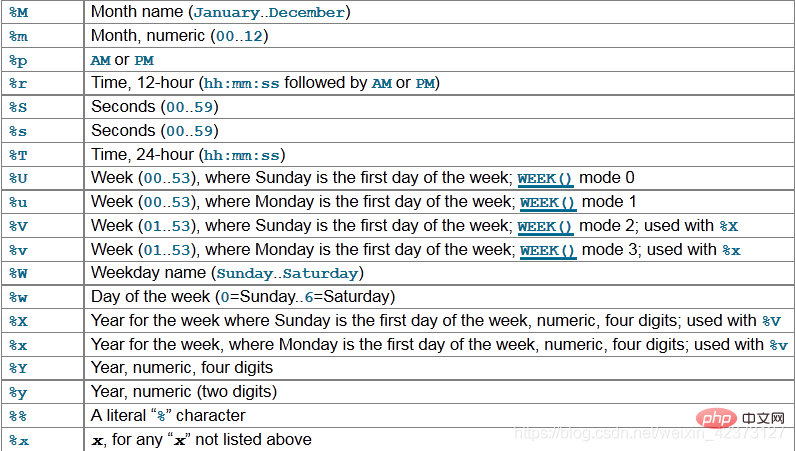How to perform type conversion in mysql
Conversion method: 1. Use the " " operator, the syntax is "SELECT 1 'String';"; 2. Use the CAST() function to convert any type to a specified type, the syntax is "CAST(expr AS type)"; 3. Use the DATE_FORMAT() function to convert the date into a string according to the given pattern.

The operating environment of this tutorial: windows7 system, mysql8 version, Dell G3 computer.
1. The concept of implicit type conversion and explicit type conversion
Implicit type conversion:
To perform operations or comparisons between two values, the data types must first be consistent. Implicit type conversion occurs when two data types are found to be inconsistent. For example, convert a string into a number, or vice versa:
SELECT 1+'1'; – 字符串1转成数字 SELECT concat(2,'test'); – 数字2转成字符串
Explicit type conversion:
Use functions to convert data types
2.Cast function
##CAST(expr AS type)
- BINARY[(N)]: binary string, the length after conversion is less than N bytes (if the length is less than N, 0x00 will be added at the end)
- CHAR[(N)]: String, the length after conversion is less than N characters
- DATE: Date
- DATETIME: Date and time
- DECIMAL[(M[,N])]: Floating point number, M is the total number of digits (including the integer part and the decimal part) , N is the number of digits after the decimal point ##SIGNED [INTEGER]: Signed integer
- TIME: Time
- UNSIGNED [INTEGER]: Unsigned integer
When converting to decimal, scan characters from the beginning String up to the first non-numeric character. Round the truncated digit
1) By default, M and N are not limited, converted to an integer, and rounded to the first decimal place:SELECT cast(‘28.82abc’ AS DECIMAL);

SELECT cast(‘28.82abc’ AS DECIMAL(4));
 If M When the length is less than the actual number of digits, it will be converted to the maximum value of the set number of digits. In the following conversion, M is 1, that is, the two-digit number 29 cannot be displayed, and the largest one-digit number, 9
If M When the length is less than the actual number of digits, it will be converted to the maximum value of the set number of digits. In the following conversion, M is 1, that is, the two-digit number 29 cannot be displayed, and the largest one-digit number, 9
SELECT cast(‘28.82abc’ AS DECIMAL(1));
 , is limited to M and N, which must be First satisfy N decimal places after the decimal point. In the following example, 1 decimal place is satisfied first, and then 1 integer is taken:
, is limited to M and N, which must be First satisfy N decimal places after the decimal point. In the following example, 1 decimal place is satisfied first, and then 1 integer is taken:
SELECT cast(‘28.82abc’ AS DECIMAL(2,1));
 2 decimal places are satisfied first, and the integer part is not taken:
2 decimal places are satisfied first, and the integer part is not taken:
SELECT cast(‘28.82abc’ AS DECIMAL(2,2));
SELECT cast(‘28.82abc’ AS UNSIGNED);


SELECT cast(’-28abc’ AS SIGNED);

SELECT cast(‘2007-12-25’ AS DATETIME);
SELECT cast(‘2007-12-25’ AS DATE);

SELECT cast(‘20:20:20’ AS TIME);

The date format must be 'YYYY-MM-DD'
SELECT cast(‘25-12-2007’ AS DATETIME); SELECT cast(‘2007-may-25’ AS DATETIME);


SELECT cast(123 AS CHAR);
SELECT cast(123 AS BINARY);
SELECT cast(now() AS CHAR);

二进制字符串:二进制字符串被视为一个连续的字节序列,与字符集无关。非二进制字符串(即我们通常所说的字符串)被视为一个连续排列的字符序列,与字符集有关。所谓与字符集无关,是指与MySQL自己的字符集无关,而是按照操作系统的字符集把字符串转换成字节进行存储 两种字符串的比较方式:二进制字符串的比较方式是一个字节一个字节进行的,比较的依据是两个字节的二进制值。因为同一个字母的大小写的数值编码是不一样的,因此它是区分大小写的。另外,由于它和字符集无关,因此也就没有大写和小写字母一说 非二进制字符串的比较方式是一个字符一个字符进行的,比较的依据是两个字符在字符集中的先后顺序。根据使用的校对不同,可以进行区分大小写的比较和不区分大小写的比较 使用CAST(str AS BINARY)将字符串转换成二进制字符串时,通常使用它的快捷方式写法: BINARY str 查看当前字符集和校对规则设置 在比较表达式中,binary影响后面所有的字符串,并且不会忽略字符串的尾部空格 Cast(col_name as date_type) 将指定的列或者表达式转换为指定的数据类型 使用场景:当两个值进行比较,但是数据源的表中列的数据不一致,这个时候可以使用cast函数进行转化 3.Convert函数 CONVERT(expr, type), CONVERT(expr USING sharset_name) convert函数的作用和cast函数几乎相同,但是它可以把字符串从一种字符集转换成另一种字符集。下例将字符串’abc’从默认的字符集转换成utf8字符集 如果目标字符集不能表示该字符,则返回乱码 日期字符串转换函数 DATE_FORMAT(date, format) 将日期date按照给定的模式format转换成字符串。format中可使用以下模式元素 TIME_FORMAT(date, format) format中只可使用时、分、秒和微秒模式元素 STR_TO_DATE(str, format) 将字符串str以指定的模式format转换成日期。format中可以包含模式元素和字面量,字面量必须匹配str中的字面量: 【相关推荐:mysql视频教程】 The above is the detailed content of How to perform type conversion in mysql. For more information, please follow other related articles on the PHP Chinese website!SHOW VARIABLES LIKE ‘collation_%’;

SELECT ‘a’ = ‘A’ ,BINARY ‘a’ = ‘A’;
SELECT ‘a’ = 'a ',BINARY ‘a’ = 'a ';


SELECT convert(‘abc’ USING utf8);

SELECT convert(‘你好’ USING gbk);

SELECT convert(‘你好’ USING latin1);



SELECT date_format(‘2009-10-04 22:23:00’, ‘%W %M %Y’);

SELECT date_format(now(), ‘%W %M %Y’);

SELECT date_format(‘2007-10-04 22:23:00’, ‘%H:%i:%s’);

SELECT time_format(‘22:23:01’, ‘%H.%i.%s’);

SELECT str_to_date(‘01,5,2013’,’%d,%m,%Y’);
SELECT str_to_date(‘May 1, 2013’,’%M %d,%Y’);

以下在会话变量@@sql_mode设置中包含no_zero_date和no_zero_in_date时转换失败,没有包含这些设置时转换成功SELECT str_to_date(‘a09:30:17’,‘a%h:%i:%s’);
SELECT str_to_date(‘09:30:17a’,’%h:%i:%s’);



Hot AI Tools

Undresser.AI Undress
AI-powered app for creating realistic nude photos

AI Clothes Remover
Online AI tool for removing clothes from photos.

Undress AI Tool
Undress images for free

Clothoff.io
AI clothes remover

Video Face Swap
Swap faces in any video effortlessly with our completely free AI face swap tool!

Hot Article

Hot Tools

Notepad++7.3.1
Easy-to-use and free code editor

SublimeText3 Chinese version
Chinese version, very easy to use

Zend Studio 13.0.1
Powerful PHP integrated development environment

Dreamweaver CS6
Visual web development tools

SublimeText3 Mac version
God-level code editing software (SublimeText3)

Hot Topics
 1386
1386
 52
52
 MySQL: Simple Concepts for Easy Learning
Apr 10, 2025 am 09:29 AM
MySQL: Simple Concepts for Easy Learning
Apr 10, 2025 am 09:29 AM
MySQL is an open source relational database management system. 1) Create database and tables: Use the CREATEDATABASE and CREATETABLE commands. 2) Basic operations: INSERT, UPDATE, DELETE and SELECT. 3) Advanced operations: JOIN, subquery and transaction processing. 4) Debugging skills: Check syntax, data type and permissions. 5) Optimization suggestions: Use indexes, avoid SELECT* and use transactions.
 How to open phpmyadmin
Apr 10, 2025 pm 10:51 PM
How to open phpmyadmin
Apr 10, 2025 pm 10:51 PM
You can open phpMyAdmin through the following steps: 1. Log in to the website control panel; 2. Find and click the phpMyAdmin icon; 3. Enter MySQL credentials; 4. Click "Login".
 MySQL: An Introduction to the World's Most Popular Database
Apr 12, 2025 am 12:18 AM
MySQL: An Introduction to the World's Most Popular Database
Apr 12, 2025 am 12:18 AM
MySQL is an open source relational database management system, mainly used to store and retrieve data quickly and reliably. Its working principle includes client requests, query resolution, execution of queries and return results. Examples of usage include creating tables, inserting and querying data, and advanced features such as JOIN operations. Common errors involve SQL syntax, data types, and permissions, and optimization suggestions include the use of indexes, optimized queries, and partitioning of tables.
 How to use single threaded redis
Apr 10, 2025 pm 07:12 PM
How to use single threaded redis
Apr 10, 2025 pm 07:12 PM
Redis uses a single threaded architecture to provide high performance, simplicity, and consistency. It utilizes I/O multiplexing, event loops, non-blocking I/O, and shared memory to improve concurrency, but with limitations of concurrency limitations, single point of failure, and unsuitable for write-intensive workloads.
 Why Use MySQL? Benefits and Advantages
Apr 12, 2025 am 12:17 AM
Why Use MySQL? Benefits and Advantages
Apr 12, 2025 am 12:17 AM
MySQL is chosen for its performance, reliability, ease of use, and community support. 1.MySQL provides efficient data storage and retrieval functions, supporting multiple data types and advanced query operations. 2. Adopt client-server architecture and multiple storage engines to support transaction and query optimization. 3. Easy to use, supports a variety of operating systems and programming languages. 4. Have strong community support and provide rich resources and solutions.
 MySQL's Place: Databases and Programming
Apr 13, 2025 am 12:18 AM
MySQL's Place: Databases and Programming
Apr 13, 2025 am 12:18 AM
MySQL's position in databases and programming is very important. It is an open source relational database management system that is widely used in various application scenarios. 1) MySQL provides efficient data storage, organization and retrieval functions, supporting Web, mobile and enterprise-level systems. 2) It uses a client-server architecture, supports multiple storage engines and index optimization. 3) Basic usages include creating tables and inserting data, and advanced usages involve multi-table JOINs and complex queries. 4) Frequently asked questions such as SQL syntax errors and performance issues can be debugged through the EXPLAIN command and slow query log. 5) Performance optimization methods include rational use of indexes, optimized query and use of caches. Best practices include using transactions and PreparedStatemen
 MySQL and SQL: Essential Skills for Developers
Apr 10, 2025 am 09:30 AM
MySQL and SQL: Essential Skills for Developers
Apr 10, 2025 am 09:30 AM
MySQL and SQL are essential skills for developers. 1.MySQL is an open source relational database management system, and SQL is the standard language used to manage and operate databases. 2.MySQL supports multiple storage engines through efficient data storage and retrieval functions, and SQL completes complex data operations through simple statements. 3. Examples of usage include basic queries and advanced queries, such as filtering and sorting by condition. 4. Common errors include syntax errors and performance issues, which can be optimized by checking SQL statements and using EXPLAIN commands. 5. Performance optimization techniques include using indexes, avoiding full table scanning, optimizing JOIN operations and improving code readability.
 Monitor Redis Droplet with Redis Exporter Service
Apr 10, 2025 pm 01:36 PM
Monitor Redis Droplet with Redis Exporter Service
Apr 10, 2025 pm 01:36 PM
Effective monitoring of Redis databases is critical to maintaining optimal performance, identifying potential bottlenecks, and ensuring overall system reliability. Redis Exporter Service is a powerful utility designed to monitor Redis databases using Prometheus. This tutorial will guide you through the complete setup and configuration of Redis Exporter Service, ensuring you seamlessly build monitoring solutions. By studying this tutorial, you will achieve fully operational monitoring settings




